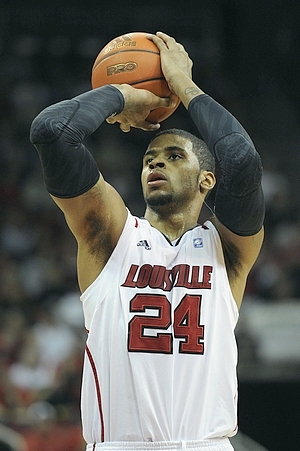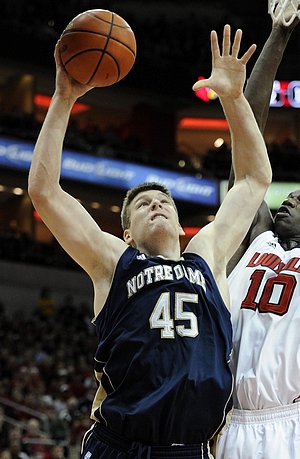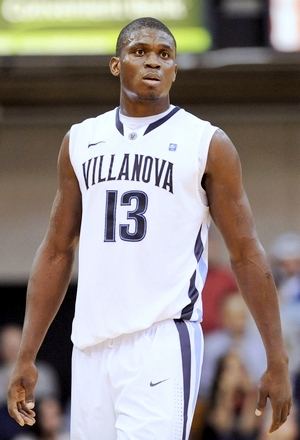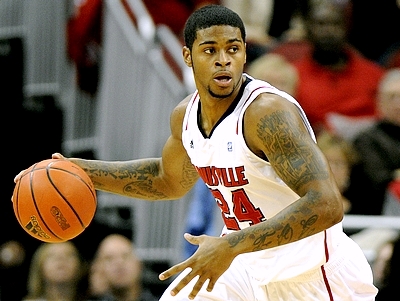Incoming freshmen have been excluded from these previews, as we'd like to wait and see what they have to offer on the NCAA level before we come to any long-term conclusions.
-Top 20 NBA Prospects in the Big Ten
-Top 20 NBA Prospects in the ACC
-Top 11 NBA Prospects in the Big XII
-Top 15 NBA Prospects in the Pac-12
-Top NBA Draft Prospects in the Big East, Part One
(#1) Otto Porter Video Scouting Report
-Top NBA Draft Prospects in the Big East, Part Two
(#2) Michael Carter-Williams
(#3) Gorgui Dieng
(#4) Rakeem Christmas
(#5) Jerian Grant
#6, Chane Behanan, 6'7, Power Forward, Louisville, Sophomore

Kyle Nelson
Louisville big man Chane Behanan had a breakout NCAA Tournament, averaging 13.2 points and eight rebounds per game as a key contributor in Louisville's run to the Final Four, winning him West Regional Most Outstanding Player awards. Behanan's late-season heroics followed an already impressive freshman campaign, one in which the freshman garnered Big East All-Rookie team honors and solidified his role as the starting power forward on a top-25 caliber team. Louisville is primed for another deep tournament run and Behanan will once again have the opportunity to shine for the Cardinals as a sophomore.
Behanan's post prowess is all the more remarkable given his lack of ideal size, as he stands just 6'6 in bare feet and around 6'7 in shoes with an unimpressive 6'8 wingspan. He makes up for it with his strong and rugged 253-pound frame, which shows both room to slim down and the potential to add more bulk. He is a solid athlete for his size, as well, with excellent mobility and decent explosiveness, who runs the floor hard in transition.
Behanan thrives offensively around the basket, where he finds most of his offensive possessions, making 56% of his field goal attempts inside the arc. Utilizing his excellent scoring instincts, Behanan is a good post finisher at this level, moving into space and attacking the basket hard. He is at his best pulling in offensive rebounds around the basket, finishing off cuts to the basket, and by simply being in the right place at the right time in the post.
While Behanan finds most of his offense around the basket, less than 20% of his shots come out of traditional post up situations. Behanan does an excellent job of carving out space and holding his position while showing solid hands reigning in errant passes. He struggles with his footwork, as he really only has a handful of consistent moves, a running jump hook with his right hand or a fadeaway jumper. Improving here, given his lack of ideal size, is obviously very important.
He also must improve his pick-and-roll game, as he shows some versatility as a finisher, but is not a particularly good screener and rarely rolls hard to the basket. At this point, he often parks himself on the perimeter, where he shows some potential to knock down shots, but made just 21.3% of his 47 attempts. Furthermore, he made just six of his 36 attempts from beyond the arc and less than 60% of his foul shots. On film, his mechanics actually look solid, though he shows a bit too much movement in his lower body and an inconsistent release.
He showed the beginnings of a solid face-up game, as well, putting the ball on the floor and getting to the basket, but his shaky handles and general lack of creativity as a scorer limited him in this area. Like many of his weaknesses, however, it is not hard to imagine him improving significantly between his freshman and sophomore years, as Behanan will be expected to score more than 9.5 points per game as a sophomore and he showed quite a bit of versatility and improvement as the season progressed.
Seeing heavy minutes next to a somewhat limited scorer in Gorgui Dieng, Behanan's ability to knock down open jumpers will dramatically improve Louisville's spacing this season.
Defensively, his huge frame and solid lateral quickness allow him to compensate somewhat for his lack of size, average wingspan and lack of elite explosiveness. For the most part, he holds his own on the blocks and does a solid job of sticking with bigger players off of the dribble. The most significant problem at this stage lies in his questionable ability to defend perimeter oriented big men. Most notably, he fails to close out on shooters and struggles at times to guard the pick-and-roll.
While he was solid on defense as a freshman, he has to be more consistent, showing greater focus and versatility at all times on the defensive end. In addition to his aforementioned flaws, improving on the defensive glass, therefore, remains a priority both in terms of fundamentals and effort. During his sophomore season, for instance, it would be great to see Behanan boxing out automatically on shot attempts, winning scrums in traffic and aggressively hauling down errant shots.
Behanan is already one of the top returning rebounders in our top-100 who proved his reputation as a hard-working, tough player on one of the largest stages in college basketball and seems primed on a strong sophomore season. As he lacks ideal size for the position, he must continue to compensate with sheer effort and intensity while showing scouts that he is versatile enough offensively to crack a rotation in a variety of different ways at the next level.
#7, Wayne Blackshear, 6-6, Sophomore, SG/SF, Louisville
Battling injuries as a freshman, and played a limited role in which he was highly inconsistent, we prefer to wait and see how Blackshear bounces back as a sophomore before adding to his scouting report.
#8, Jack Cooley, 6-9, Center, Senior, Notre Dame

Jonathan Givony
Seeing limited playing time in his first two years at Notre Dame, few could have envisioned Jack Cooley developing into one of the most productive big men in the Big East as a junior. That's exactly what he did, though, leading the conference in rebounding per-40 minutes pace adjusted and True Shooting Percentage, while finishing 11th in scoring.
A 6-9 center with a strong, wide and well-conditioned frame, almost all of Cooley's offense comes right around the basket. He does a terrific job of establishing deep post-position thanks to his excellent lower body strength, and doesn't have any qualms banging up against his opponent ferociously to carve out an extra inch or two of space to get his shot off. He also sets very good screens, and shows perfect timing rolling to the rim, having soft enough hands to catch virtually anything thrown his way, and excellent touch finishing off the glass, with either hand.
In addition to his proficiency finishing off cuts and pick and rolls, Cooley is one of the most effective back to the basket scorers in all of college basketball. He sees more than a third of his half-court touches in post-up situations, and scores 1.063 points per possessions on them according to Synergy Sports Technology, which ranked in the top-10 amongst collegiate players with 100+ post-touches.
He doesn't have a terribly diverse arsenal in terms of advanced footwork and moves, though, as most of his post-offense is heavily predicated on him establishing and catching the ball with one or two feet in the paint, and he tends to struggle dealing with double teams. NBA scouts may wonder whether he can continue to score in this manner against better competition, as the big men at the next level are generally much taller, stronger, longer and more athletic.
With that said, there is no question that Cooley's style is brutally effective at the college level, as he scored at a very high rate last season, shooting a terrific 63% from the field, #1 in the Big East by a wide margin. He also gets to the free line relatively often, and makes 68% of his attempts once there.
Cooley is also a force on the offensive glass, pulling down 5.8 offensive rebounds per-40 minutes pace adjusted, which ranked #1 amongst all prospects last season. He attacks loose balls coming off the rim with reckless abandon, showing a terrific activity level and great timing. Unlike his post-game, these are things which would undoubtedly translate in some shape or form to any level he played at.
One part of his offensive arsenal that NBA scouts may have questions about is his mid-range jumper. This isn't a part of his game he's asked to display very often, as he only took a dozen or so jump-shots all of last season, some of which he actually managed to convert. Based on the hesitance he showed taking these shots, it doesn't look like this is something he's incredibly comfortable doing right now. Considering he'll likely be asked to move down a position and spend most of his time at the power forward spot, this is a part of his game he'll probably be asked to develop in time.
Likewise for his ability to put the ball on the floor from the perimeter or make plays for teammates things he simply isn't asked to do as a center in Notre Dame's offense. Cooley dished out an assist on just 6.6% of his used possessions. To his credit, though, he is not a turnover prone player. He's simply used as a finisher, not a creator.
The biggest concerns Cooley will face making the transition to the pro level will likely revolve around his play on the defensive end. Spending all of his minutes at the center position, he really struggles any time he's asked to step out outside and guard a perimeter oriented big man. Looking very upright in his stance, and showing poor lateral quickness, Cooley has a difficult time bending his knees and moving his feet effectively, usually letting players drive right by him when being isolated against. At the college level his team can just go into a zonewhich Notre Dame often doesbut in the NBA that's not as much of an option. If he's going to transition to the power forward spot, this is something he'll likely have to overcome.
Playing man to man defense inside the post, Cooley is a little bit more effective, thanks to his strong frame and high activity level. He tends to struggle here too at times, though, giving up deep post position and allowing taller big men to shoot over the top of him. The Big East didn't have very many talented back to the basket players who could expose him too badly last season, but he did have some poor outings against some fairly undistinguished big men.
Cooley does show very good timing as a weakside shot-blocker, doing a nice job protecting the rim last season. He rotates very well inside the paint, rejecting shots with either hand, and usually keeps his blocked shots in-bounds, which is an added bonus. On top of that, he's also a pretty good defensive rebounder, ranking third in the Big East in that category on a per-minute basis last year.
All things considered, Cooley is likely to get some very strong looks from the NBA at the end of the season, provided his junior year performance wasn't a fluke and he's able to make some progress on some of the weaknesses outlined above. Solidly built 6-9 big men who can score, rebound and block shots and play both hard and smart don't grow on trees, so there's a good chance Cooley will get an opportunity to show he belongs.
#9, Peyton Siva, 5-11, Point Guard, Senior, Louisville

Joe Treutlein
Following a breakout sophomore season, Peyton Siva didn't take much of a next step forward as a junior, posting similar numbers in most areas while actually regressing slightly in some. Still, Siva played a key role on a Louisville team that advanced to the Final Four and returns most of its top talent this season, making him well positioned to take that next step this year.
On the offensive end, Siva remains mostly the same player we profiled a year ago, as he didn't improve noticeably in any of his weaker areas and actually declined further in a few, namely his all-around scoring ability. Siva's unimpressive outside shooting numbers and struggles with turnovers were his two biggest issues as a sophomore, and he actually managed to get worse in both areas as a junior.
While the turnovers are to be expected somewhat given his high octane style of play, his inability to develop into a more respectable spot-up shooter from three-point range is much more concerning, especially at his size. There are question marks about how his inside game will translate to the pros, so getting it together and developing his jumper will be good insurance for him at worst and could make him into a much more dynamic offensive player at best.
Siva's ability to finish inside the arc also took a big step back as a junior, as his two-point percentage plummeted from a strong 54.3% to an unimpressive 44.8%. Siva's probably not as good as he looked in this area as a sophomore or as bad as he looked as a junior, but he showed considerable struggles dealing with crowded lanes and weak side help on his forays to the basket, not having the size to consistently get off high percentage shot attempts inside. The NBA's more spread out and isolation-oriented offensive systems could help him some in the pros, but improving his shot-selection inside the arc and touch around the basket would help him considerably.
The most interesting aspect of Siva's scoring game is how heavily reliant he is on pick-and-rolls, something that isn't always beneficial against college defenses but could work much better to his favor in the right system in the pros. Siva sees an absurd 44.4% of his possessions out of pick-and-rolls according to Synergy Sports Technology, and his ability to get separation with his incredibly quick first step is outstanding. Developing a jump-shot to make him more of a multi-threat in these situations would help him, but he's already very difficult to contain just by virtue of how fast and explosive he is.
Siva's passing game is still a very strong spot for him, and his 6.8 assists per pace adjusted 40 minutes ranks 4th in our top 100 prospects. Turnovers remain a significant problemas he coughed the ball up on an absurdly high 31% of his possessions--but Siva shows excellent vision operating out of pick-and-rolls and does a very good job finding the open man when his dribble-drives inevitably cause the defense to collapse on him.
While Siva took a step back on the offensive end as a junior, fortunately for him the opposite can be said on the other side of the ball, where he did some nice maturing this past year. Cutting down on the gambling and excessive swipes for the ball we outlined in our last profile of him, Siva saw his pace-adjusted steals drop noticeably this year, but more than made up for it with his improvement in overall man-to-man defense. Siva is now doing a much better job staying locked in on his man, moving his feet, and not giving up plays, doing a better job contesting in isolations and keeping his man in front of him. He's still prone to getting pushed around by more physical opponents, something that will always be an issue for him at his size, but he's making much better use of the tools he has and taking advantage of his excellent foot speed while getting his hands up to contest shots the best he can.
Looking forward, Siva has some work to do as a senior, trying to return his offensive performance to what he did as a sophomore, while also hopefully finally developing the jump shot that could really round out his game. Projecting to the NBA, Siva is an excellent stylistic fit for the direction many teams have been going with their guard play, having the combination of elite quickness, passing ability, and pick-and-roll prowess that coaches value. His offensive game is almost certainly more suited for the pros than the collegiate game, but his turnover proneness, lack of outside shooting, and questionable ability to finish inside are still significant marks, and he'll likely need to show considerable improvements in at least one of those areas to find himself a long-term niche in the league.
#10, Mouphtaou Yarou, 6'9, Senior, Center, Villanova

Matt Williams
A prospect we've covered in detail on five separate occasions over the past few years, Mouphtaou Yarou is one of the only returning seniors on Jay Wright's roster. The Benin native's junior season was not a major departure from what we saw from him as a sophomore he was a rock solid rebounder, provided a physical presence around the basket defensively, and showed nominal progress in a marginally bigger offensive role. With Maalik Wayns and Dominic Cheek moving on to the professional level, Villanova will look to a number of newcomers to help fill the void in its backcourt. Yarou's ability to become a more polished offensive player and mesh with his new teammates will be a key to the Wildcat's success and his draft stock.
A 6'9 center with a 6'11 wingspan, Yarou's biggest strength is his ability to use his 250-pound frame to be a presence on the glass and on the defensive end. An average athlete, Yarou lacks great agility and operates mostly below the rim, but compensates with a solid mobility, a terrific motor, and a willingness to be physical in the paint.
On the offensive end, Yarou remains capable, but raw, and has yet to answer many of the questions we outlined in our last report. He scores in the post with a basic repertoire of moves, finishes at a good rate around the basket, and is a stand out rebounder at the college level, but he still lacks polish, appears mechanical at times, and is limited in his ability to make major contributions on this end of the floor with any consistency.
Yarou did take significantly more jump shots last season than he did as a sophomore, seemingly trying to become a more versatile offense threat. Finding mixed results, he connected on 15 of the 44 jumpers he attempted, but still has plenty of work to do to become a competent midrange scorer and a more viable offensive weapon on the whole.
Defensively, Yarou's motor allows him to be a factor in the paint and on the boards as he tries to get his hands on every loose ball. His inability to change directions quickly limits him away from the basket to some degree and he finds himself out of position at times, particularly guarding the pick and roll, but he seldom gives up on plays. Making some terrific plays rotating over from the weakside, Yarou has all the tools to capably defend at the NBA level. He didn't block shots at quite the same rate he did as a sophomore, but didn't foul at as high a rate either, doing a better job going straight up and simply absorbing contact right into his chest.
One of the top senior prospects at the center position, Mouphtaou Yarou has yet to live up to the lofty expectations set for him earlier in his career. He's made small, consistent improvements in each of his seasons at Villanova, but a breakout year, especially on the offensive end, could help him regain some of the momentum he's lost among NBA decision-makers in recent seasons.






























Comments